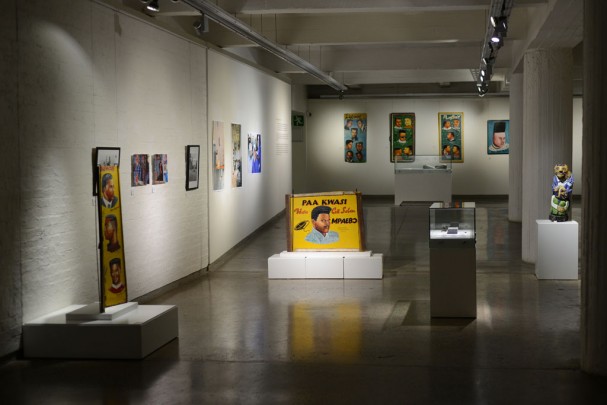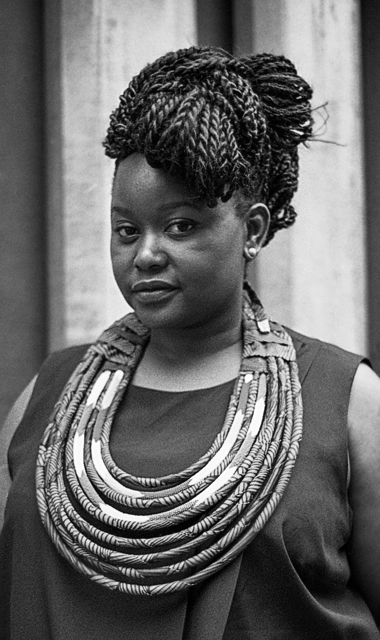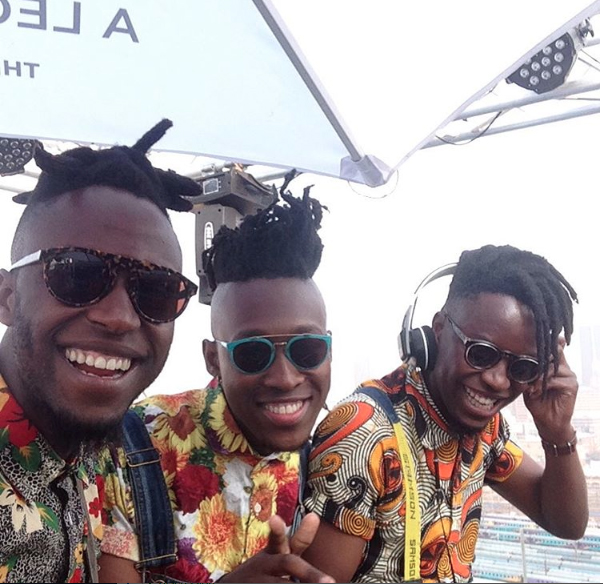The Architecture of Hair
By Kira Kemper
Like the oppressive New York-style architecture in Johannesburg CBD, hair in Africa has similarly aspired to a set of Western ideals. The issues and controversy surrounding black hair in Africa are constantly underplayed, ignored in favour of a Western viewpoint which rules the corporate world and the schooling systems. Hair, in its common everydayness, is easy to ignore. Hair is seen as fashion, as frivolous and indulgent. However deep within the common lies the personal spaces that hair alludes to. It accesses the quiet, brewing self where our worth as humans is generated or chipped away. Hair is growing into our art world, being seen as a sociocultural practice and art form, but also importantly as a political keystone, which unlocks strongholds of institutionalized oppression and obliviousness.
In August last year, the Wits Art Museum (WAM) opened a highly controversial exhibition entitled ‘Doing Hair: Art and Hair in Africa’. Sponsored by Black Like Me and curated by a large team, the aim of the exhibition was to engage with Braamfontein through this topical and challenging theme. Following the opening, Twitter exploded with anger towards the mainly white curators, the ethnographic feeling of the museum setting, and the subject matter in general.
The exhibition was divided into four parts: Hair paraphernalia, including African traditional combs, masks and ethnographic drawings and photographs; Hair: Power, society and standards of beauty, a more contemporary section including the work of Paul Emmanuel, videos of hair care advertisements and a video of a teacher forcing her students to shave their heads to keep ‘gangsters’ away; A cut above the rest (barbershop culture), including wooden barbershop signs, stylized hand-painted portraits of different hairstyles; and Inseparable (depilation/ hair removal), including a mixture of contemporary art, Pieter Hugo prints of black judges in white wigs, and traditional objects related to the topic.
The show attempted to create a dialogue between hair as seen then and now in a broad, sweeping way. Historic ethnographic examples of African hairstyles in the form of problematic case studies and Nigerian ceremonial masks were in juxtaposition to Youtube advertisements aimed at black women for chemical hair straighteners and other products.
The catalogue accompanying the show provided a thorough explanation of the exhibition, engaging each section, the problematics and the curatorial strategy. But at R250 each many people walked through the show blindly, and left offended . A critical moment in the exhibition was the inclusion of vanity mirrors, surrounded by carved images of different hairstyles. The mirrors were included in an attempt to give the viewers the opportunity to look at themselves and consider their own hair while an advertisement announced in the background, ‘For hair that is straight and incredibly shiny, up your social status; get tweetable, likeable hair.’ The effect of these mirrors and perhaps of the exhibition itself succeeded only in making the viewer an object of the white othering gaze.
Milisuthando Bongela/ Miss Milly B, a Feminist Stokvel member, fashion blogger and activist, was asked to open the exhibition. The Feminist Stokvel are a group of eight young black women who are powerfully, eloquently and passionately changing perceptions and pointing out underlying institutional and inherent patriarchal and racist systems everyday through their hair.
The Feminist Stokvel holds events, organized through social media, called Hair Soirees. These events aim to create a safe space for black women to get together to talk about how to care for natural hair but also issues of self-esteem, texture discrimination, racialisation and sexualisation which all contribute to the politics of black hair. The Feminist Stokvel advocates self- care, self- love and self- actualisation; they perpetuate and inspire #blackgirlmagic.
In her opening speech Miss Milly B took a personal stance, looking at her own research into African hair in relation to history, but focusing on issues of self-esteem related to the after-effects of colonialism. While the exhibition sought to celebrate the wide variety of hairstyles in Africa, the sculptural nature of hair seen in history and hair as an expression of art, it seemed to sweep over the deeply personal hurt imposed on black women and men and the real pressure to conform to society’s norms. Miss Milly B asked the question, ‘What are the systems in place that are making black woman want to change the texture of their hair at all?’
Mpho Matsipa is another person at the forefront of this hair revolution, engaging daily with Johannesburg practically and academically while recognizing the social power of hair. In a recent workshop entitled ‘Johannesburg: Performative Urbanisms. Fighting for and over the city; Expressing the city; Knowing the city’ hosted, in part, by the WITS City Institute, Matsipa convened a panel discussion entitled Hair and the City. Matispa framed the discussion around Bree Street focusing on the hair stylists who flourish there, and who work mostly from the pavements. Joining the conversation were three other stylish women including radical feminist scholar, Danai Mupotsa and Feminist Stokvel members Danielle Bowler and Kavuli Nyali. These three together with Matsipa, riled up the room with powerful, confrontational presentations.
Matispa introduced her research into hair and the city, which is ongoing, and which considers the politics of hair in relation to the architecture of Johannesburg city. Her research into Bree Street sought to analyze the street through a visual and spatial ethnography. The project included stop-frame photography, animation and data sketching by Global Africa Lab at Columbia University, as a means to facilitate and to ‘better understand the layered temporalities and hidden architectures of the city.’ Projects like these, and the exhibitions hosted by Studio-X seek to critically engage with the city through creative endeavors, which produce real-life, tangible research outputs.
Kavuli Nyali, creator of goodhairdiaries.com, spoke about the re-emergence of natural hair in the country and of the politics surrounding this act. Deemed inappropriate in many corporate settings, natural hair is expected to be tamed, controlled and neat in the workplace. Black women are then cornered into spending thousands of rands on chemical straighteners and other products in an effort to appear more Western, more relatable and more professional, which can take an emotional, financial and physical toll. Nyali’s blog promotes healthy natural hair; it exposes the dark side of hair products that cause scalp blisters, hair loss and damage. The poignancy of Nyali’s presence on the panel was not lost on the audience. Hair is political.
Quoting Lwandile Fikeni’s recent article in the Sunday Times Lifestyle section Braamfontein: Jozi’s epicenter of indigenous cool (2015-09-06), Danielle Bowler, compared the clean, white, Nordic look of hipsters in Cape Town to the emergence of the black hipster, wearing African fabrics and embracing African hair, in Johannesburg. Drawing incredibly interesting links between gentrified spaces in the city as sites of freedom, Bowler explores hair as an extension of the black hipster identity; an element of fashion and performance in itself, an expression of uniqueness, and an act of decolonization of the personal.
This panel discussion is a great example of the captivating and interdisciplinary nature of Matsipa’s work in Johannesburg. As the curator of Studio-X Johannesburg, a creative research lab part of a large global network of studios initiated by Columbia University, Matsipa has curated a number of creative collaborative projects aimed at exploring alternate imaginaries of the city
Matsipa’s work in Johannesburg seems to negotiate deeply personal, feminine spheres through her interest in hair as a subject matter and larger processes of urban renewal. This complex space seems to extend into other spheres, into the patriarchal built environment of Johannesburg as well as the topical institutionalized residues of colonialism we are currently unpacking together as a country.

Documentation on Ruka (to braid/ to knit/ to weave), 2014 , community braiding workshop. Photo: Nontsikelelo Mutiti.
In July of this year, Matsipa organized a talk by Zimbabwean born, New York- based artist Nontsikelelo Mutiti at Fourthwall Books in Braamfontein. Mutiti discussed her work Ruka (to braid/ to knit/ to weave) that featured an intimate braiding workshop where different techniques were explored for arranging natural hair. Here Mutiti exhibited hair braiding as an art form, and emphasized the community- oriented nature of the practice. For Mutiti, living in New York, she found herself drawn to the presence of African immigrants and began exploring their connection to ‘home’ and the economic stability that braiding hair afforded them. The African hair-braiding salon is a marker of the diaspora, and perhaps for her, a personal connection to her own home.
And so hair is rumbling. It is colourful, bright braids and wigs and beads, it is dreads, cornrows and extensions, and it is natural, soft and well maintained. The importance of hair as seen in these exhibitions, conferences, and conversations is emphasized by the work of people like Mpho Matsipa and The Feminist Stokvel who are collaborating with the real Joburg, with radical black feminist thinkers, everyday hustlers, and who are creating opportunities for artists to engage with Joburg as an African city, with its African hipsters who embrace their African fabrics, black skin and their black hair.









0 comments
Leave a comment and show some love!